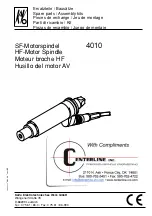
2
TOOL USE AND CARE
15.
Use clamps or other practical way to secure and support the workpiece to a stable platform. Holding the work by hand
or against your body is unstable and may lead to loss of control.
16.
Do not force tool. Use the correct tool for your application. The correct tool will do the job better and safer at the rate for
which it is designed.
17.
Do not use tool if switch does not turn it on or off. Any tool that cannot be controlled with the switch is dangerous and must
be repaired.
18.
Disconnect the plug from the power source before making any adjustments, changing accessories, or storing the tool.
Such preventive safety measures reduce the risk of starting the tool accidentally.
19.
Store idle tools out of reach of children and other untrained persons. Tools are dangerous in the hands of untrained users.
20.
Maintain tools with care. Keep cutting tools sharp and clean. Properly maintained tools with sharp cutting edge are less
likely to bind and are easier to control. Do not use a damaged tool. Tag damaged tools “ Do not use” until repaired.
21.
Check for misalignment or binding of moving parts, breakage of parts, and any other condition that may affect the tool’s
operation. If damaged, have the tool serviced before using. Many accidents are caused by poorly maintained tools.
22.
Use only accessories that are recommended by the manufacturer for your model. Accessories that may be suitable for
one tool, may become hazardous when used on another tool.
SERVICE
23.
Tool service must be performed only by qualified repair personnel. Service or maintenance performed by unqualified
personnel could result in a risk or injury.
24.
When servicing a tool, use only identical replacement parts. Follow instructions in the maintenance section of this
manual. Use of unauthorized parts or failure to follow Maintenance Instructions may create a risk of electric shock or injury.
SPECIFIC SAFETY RULES
1.
Hold tool by insulated gripping surfaces when performing an operation where the cutting tool may contact hidden
wiring or its own cord. Contact with a “live” wire will make exposed metal parts of tool “live” and shock the operator.
2.
Maintain warning label.
FUNCTIONAL DESCRIPTION
1.
Keyless Chuck
2.
Trigger lever
3.
Forward/reverse switch
4.
Cord
OPERATION
WARNING! To reduce the risk of injury always unplug tool before attaching or removing accessories or making adjustments. Use only
specifically recommended accessories. Others may be hazardous.
Installing bits
1.
Open chuck jaws wide enough to insert the bit. Be sure the shank and chuck jaws are clean. Dirt particles may prevent the bit
from lining up properly.
2.
When using drill bits, insert the bit far enough for the chuck jaws to grip the bit shank. Tighten the chuck by hand to align the
bit.
3.
To tighten, grasp and hold the drill by one hand, while rotating the chuck sleeve with your other hand. Note: Rotate the chuck
sleeve in the direction of the arrow marked GRIP to tighten the chuck.
Removing Bits
1.
To loosen, grasp and hold the drill with one hand, while rotating chuck sleeve with your other hand. Note: Rotate the chuck sleeve
in the direction of the arrows marked Release to loosen the chuck jaws.
Double Insulated
Canadian Standard Association
Underwriters Laboratories, Inc
Volts Atlernating Current
Amps
No Load RPM
SYMBOLOGY
Catalog
Volts
No Load
Twist Drill
No
AC
RPM
Capacity in Steel
8030ES
120
0-1300
3/8"
SPECIFICATIONS
1
4
2
3



































